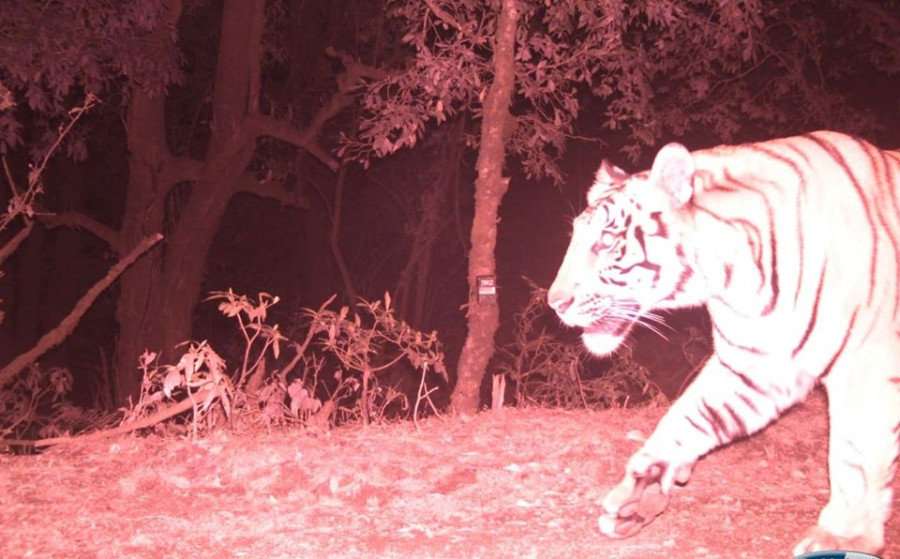Climate & Environment
Tiger sighted at a record altitude of 2,500 metres in Dadeldhura forest
Officials say more research required to find out if big cats are climbing up in search of prey or due to climate change.
Chandan Kumar Mandal
A tiger has been spotted at an elevation of 2,500 metres in Mahabharat range in the first ever sighting of the big cat at such a high altitude, according to officials. The tiger (Panthera tigris) was sighted on Monday in the forest area of Dadeldhura district.
According to Bishnu Prasad Acharya, a forest officer at the Divisional Forest Office, Dadeldhura, never before in Nepal had a tiger been spotted at 2,500 metres.
“This is a historic moment for the conservationists and the whole country where a tiger has been recorded at such higher elevation,” Acharya told the Post. “This is the first recorded sighting of a tiger at 2500 metres.”
Movement of the tiger in Dadeldhura forest areas was recorded in the camera trapping set up by the Division Forest Office to track the presence of wildlife movement in the area.
According to Acharya, locals of the Bhageshwori corridor had told forest officials about a tiger roaming in the area.
“Following their anecdotes, we decided to study the area to ascertain if there was a tiger,” said Acharya. “I had also sensed that there was a tiger, but it was still hard to believe. Therefore, we set up camera trapping in the area to track the tiger as well as other wildlife in the area.”
With financial and technical assistance support from Terai Arc Landscape Programme of World Wildlife Fund, the Forest office had installed 32 pairs of cameras in the forest area of Mahabharat area from March 6 to April 6. At one location camera captured image of a tiger in the area,
Other wild animals like leopard, red fox which is only found between 3,000-3,500 metres, large Indian civet, Himalayan goral, leopard cat and porcupine among others species were also trapped in the camera, indicating the Mahabharat range of the district is a large pool of wildlife, according to Acharya.
The highest altitude where a tiger's presence has been recorded so far is at 4,000 metres in Bhutan. In 2016, a tiger was spotted at 12,000ft in Uttarakhand, an Indian state.
In Nepal, tiger species is mainly found in its five protected areas and adjoining forest areas outside the protected parks in the low-lying Tarai belts. The Nationwide Tiger and Prey Survey 2018 recorded an impressive 19 percent increase of tiger numbers from 2013 estimate of 198 tigers, taking the national tally to 235.
The increase in number has put Nepal, which is among 13 countries bearing tiger species, ahead of meeting its commitment of doubling its tiger population by 2022 as per St Petersburg Declaration, 2010.
The 2018 survey was conducted in all potential tiger habitats in the Terai Arc Landscape (TAL)-Nepal, which is spread over 24,710 sq km and consists of 18 districts. Signs related to tiger were detected in 12 districts (Bara, Parsa, Makwanpur, Chitwan, Nawalparasi, Dang, Salyan, Banke, Bardia, Surkhet, Kailali and Kanchanpur) out of 18 districts surveyed across TAL-Nepal.
Sighting of a tiger has opened new avenues of research regarding the tiger population in the country, their prey density and their habitat. Tigers have been often sighted roaming outside the protected areas, increasing human-wildlife conflicts, and in search of prey which has slightly dwindled in protected areas and adjoining forests bearing tiger species.
“The latest sighting of the tiger has shown the big cat’s presence in Dadeldhura district. But it has added an additional chapter of tiger research in the country,” said Acharya. “We need to find out whether the tiger movement is related to climate change or search for prey or looking for a mating partner or it just lost its way.”




 7.12°C Kathmandu
7.12°C Kathmandu











